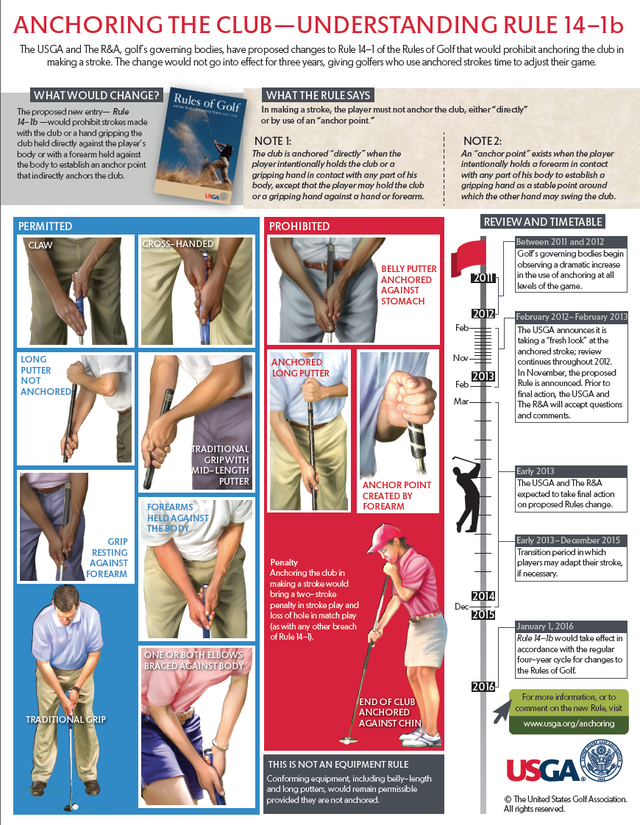When you come to think of it that is the secret of most of the great holes all over the world. They all have some kind of a twist. C.B. MACDONALD
Dawson: "We've studied the Old Course more than anyone else."
/R&A Chief Executive Peter Dawson was asked by Rich Lerner to talk about the Old Course changes on the Golf Central wrap up of the anchoring ban coverage.
His comments in their entirety:
We've studied the Old Course more than anyone else.
Actually, I'd take Old Tom Morris, Bernard Darwin and Alister MacKenzie any day in that division (and they're dead!), but go on...
We do know that over time there have been many changes to the Old Course, bunkers have gotten smaller, there were three bunkers that don't exist now. Rough has grown up in places it never used to be.
 Image Courtesy of Golf ChannelYes and I wonder who did that?
Image Courtesy of Golf ChannelYes and I wonder who did that?
Rough has been removed from places where it once was. And the changes we're putting in now, and let me just zone in on two of them now. The Road bunker, which is rebuilt almost annually at St. Andrews because it gets so much traffic, that bunker has never been the same from one Open Championship to the next. And what we're doing this time is finalizing a design, enshrining that so that every rebuild of the bunker in the future will be the same as it has been this year.
Why that entails reshaping the front of the green well separate of the bunker, I have no idea.
And the eleventh green, which is getting quit a lot of publicity I noticed, well the left hand half of that green at modern green speeds in the summer time just can't house a pin position, a hole location.
Oh boy, he said pin position. If he'd said sand trap too he would have been forced to resign! #it'sholelocationtothebluecoatsoftheworld.
Because the slopes on that green, which were absolutely fine at green speeds a century ago, make that side of the green unusable either for championship or every day play.
Or even green speeds a decade or two ago. What changed? Ah right, the mowing heights and quality of the mowers and knowledge of the greenkeepers. How about we set an example and slow down the green?
So just a small reduction in the slope of that green will open up the green for a much wider range of pin positions close to Hill bunker, where Bobby Jones famously came to grief and will even the wear out on the green from a maintenance point of view. These are sensible changes being proposed by people who love and cherish the Old Course.
Proposed? More like dumped on a Friday, started on a Monday and without telling just about anyone!
Brett Cyrgalis talked to Dawson yesterday and also looked at the controversy for the New York Post. He had this from Dawson:
“I’m more than happy to walk around the Old Course with any architect that wants to see it,” Dawson added. “We know that piece of land and cherish it like no one else.”
Aren't all golfers architects?
Miceli Melts! The $2 Nassau Is Under Siege!
/Sporting his winter professorial beard, Golfweek's Alex Miceli talks to his laptop camera about today's USGA/R&A teleconference…and the $2 Nassau is under siege! How's that for a tease?
Five Families Clash: PGA Of America Has "Concerns with any legislation that might infringe on the enjoyment of the game."
/"The last time something this popular was banned it was called prohibition and that didn't go over so well."
/Video: USGA and R&A Anchoring Ban Teleconference
/In case you missed the teleconference to discuss the anchoring ban, Golf Channel has posted it.
The transcript is here.
First Anchoring Ban Question: Where Was The Data?
/The USGA and R&A did an excellent job presenting their case both verbally and visually for the anchoring band. But I think many of us were anticipating some meaty empirical data to back up the USGA's case that players switching to this method have benefitted.
Graeme McDowell had suggested from his conversation with the USGA's Mike Davis that there would be data to back up the argument for this ban. (Brandel Chamblee had more empirical data on Golf Channel than the governing bodies presented and I hope to get that video up later.) Randall Mell touched on this topic:
Randall Mell touched on this topic:
The USGA cites no controlled studies or experiments or research to support its argument that a new definition of a stroke is needed, and that will make the decision feel arbitrary to critics. It’s the Justice Potter Stewart deal. The USGA and R&A know wrong when they see it, and they saw the game changing quickly in ways they don’t like.
The lone data seems to be this, noted by Mike Stachura.
He also pointed to usage data that suggested belly and long putters were used by three to four percent of tour players from the 1980s through the mid-2000s before a sudden upsurge.
Davis said that in 2011 the number was 11 percent, and in 2012 it was 15 percent, and as high as 20 or 25 percent in some events. More importantly, Davis said, "in the junior game, where we've seen virtually no anchoring before, all of a sudden it's started to appear. And that caused us to say, 'Is this what we really want the game of golf to be in the future?' We came to the conclusion that fundamentally that's not part of golf."
Is this enough data to make the case?
Anchoring Ban Instant Poll: Do You Support Rule 14-1b As Proposed By The Governing Bodies?
/A simple warm-up question...
Gary Player On Old Course Changes: "Sad."
/Statements From The Tours On Anchoring Ban...
/The Rule 14-1b Do's And Don't Chart: Women Included!
/The accompanying art to the USGA and R&A press release. Nice of the R&A to allow a woman to be part of the depictions!












